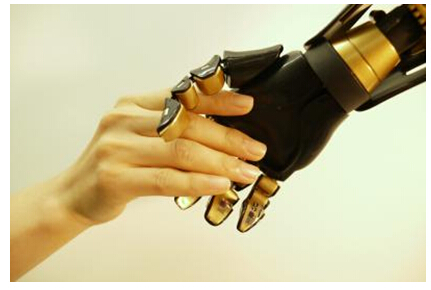
文字说明: 具有人造机械感受器的机器手与人握手。
应用柔性有机电路和专用的压力传感器,研究人员创制出了一种人工“皮肤”,它能感知静态物体的力。此外,他们还能用光遗传学方法将这些感觉信号传送至体外的小鼠脑细胞。对全世界许多用假肢生活的人来说,这样一种系统会在有一天让他们的假肢具有感觉。为了创建这种人造皮肤,Benjamin Tee 等人研发了一种专门的电路。它能通过电压机制中的某个取决于施加多少机械力而能改变电阻的成分将静压转变成数字信号。一个特别的挑战是创建能“感觉”与人类能感觉到的具有相同范围压力的传感器。因此,在这些传感器上,该小组应用了塑造成锥形微结构的碳纳米管,它们能以一种使灵敏度最大化的方式让附近物体电场的信号通往接收电极变得特别有效。传输来自人造皮肤系统的数字信号来刺激小鼠的皮层神经元被证明是又一个挑战,因为常规的光遗传学蛋白不会给出时间足够长的神经膜电位脉冲尖峰来感受这些数字信号。Benjamin Tee等人因此设计了新的光遗传学蛋白,它们能容纳更长的刺激间期。将这些新设计的光遗传蛋白用于体外的小鼠躯体感觉皮层的产生快速尖峰的中间神经元足以延长刺激间期,让这些神经元能根据数字刺激脉冲来放电。这些结果表明,该系统或能与其它产生快速尖峰的神经元(包括外周神经)兼容。
原文链接:A skin-inspired organic digital mechanoreceptor
原文摘要:Human skin relies on cutaneous receptors that output digital signals for tactile sensing in which the intensity of stimulation is converted to a series of voltage pulses. We present a power-efficient skin-inspiredmechanoreceptor with a flexible organic transistor circuit that transduces pressure into digital frequency signals directly. The output frequency ranges between 0 and 200 hertz, with a sublinear response to increasing force stimuli that mimics slow-adapting skin mechanoreceptors. The output of the sensors was further used to stimulate optogenetically engineered mouse somatosensory neurons of mouse cortex in vitro, achieving stimulated pulses in accordance with pressure levels. This work represents a step toward the design and use of large-area organic electronic skins with neural-integrated touch feedback for replacement limbs.

